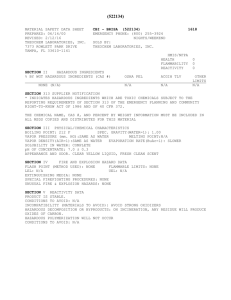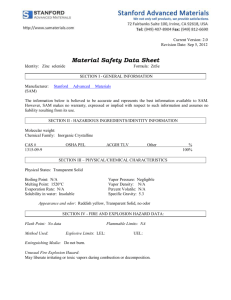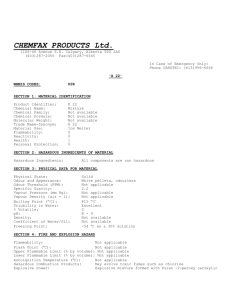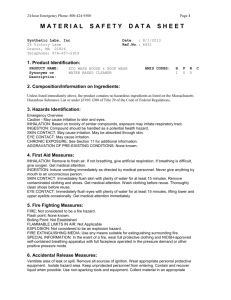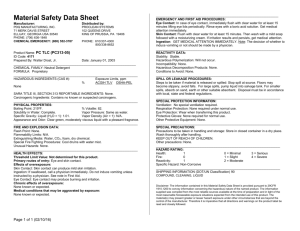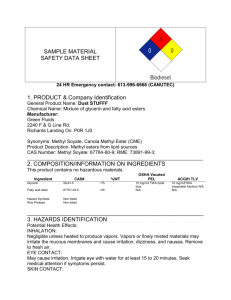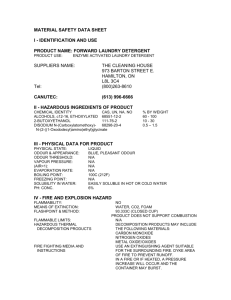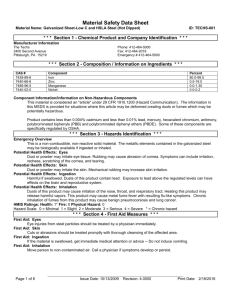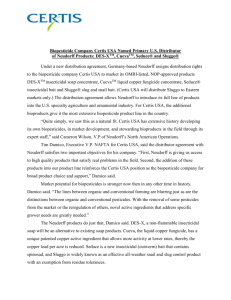1 Identification
advertisement
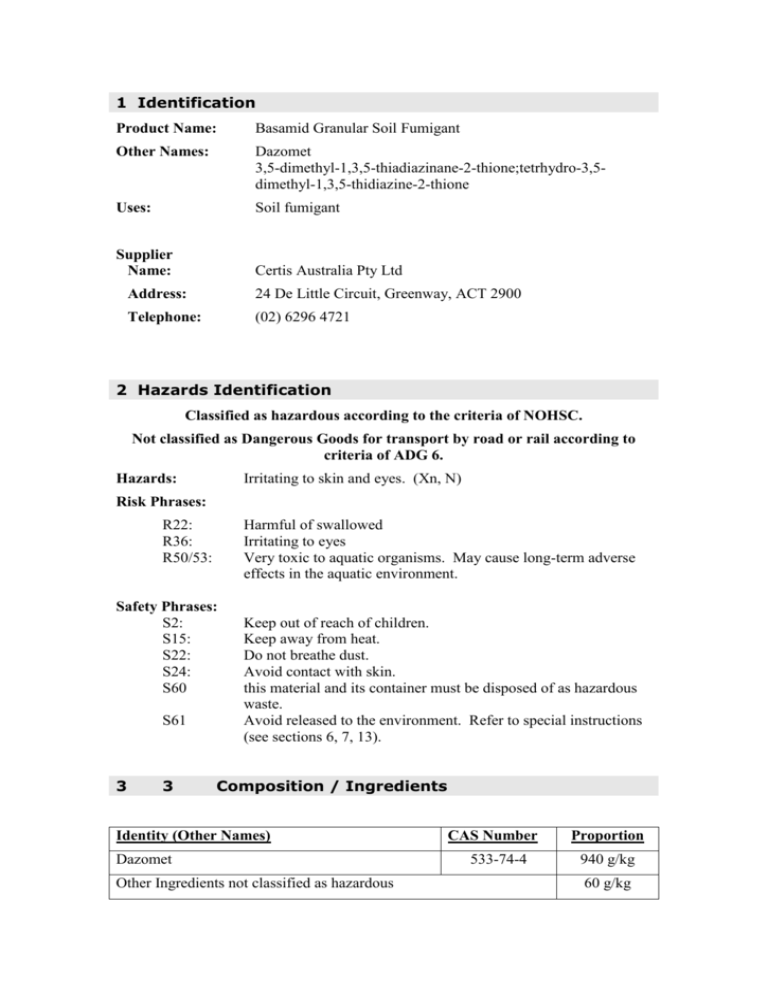
1 Identification Product Name: Basamid Granular Soil Fumigant Other Names: Dazomet 3,5-dimethyl-1,3,5-thiadiazinane-2-thione;tetrhydro-3,5dimethyl-1,3,5-thidiazine-2-thione Uses: Soil fumigant Supplier Name: Certis Australia Pty Ltd Address: 24 De Little Circuit, Greenway, ACT 2900 Telephone: (02) 6296 4721 2 Hazards Identification Classified as hazardous according to the criteria of NOHSC. Not classified as Dangerous Goods for transport by road or rail according to criteria of ADG 6. Hazards: Irritating to skin and eyes. (Xn, N) Risk Phrases: R22: R36: R50/53: Harmful of swallowed Irritating to eyes Very toxic to aquatic organisms. May cause long-term adverse effects in the aquatic environment. Safety Phrases: S2: S15: S22: S24: S60 S61 3 3 Keep out of reach of children. Keep away from heat. Do not breathe dust. Avoid contact with skin. this material and its container must be disposed of as hazardous waste. Avoid released to the environment. Refer to special instructions (see sections 6, 7, 13). Composition / Ingredients Identity (Other Names) Dazomet Other Ingredients not classified as hazardous CAS Number 533-74-4 Proportion 940 g/kg 60 g/kg 4 First Aid Measures If poisoning occurs, contact a doctor or Poisons Information Centre. Telephone 13 1126 Australia-wide. Swallowed: If conscious, immediately give large amounts of water to drink and induce vomiting. Never give anything by mouth to an unconscious person. In Eye: If product in eyes, wash it out immediately with water. Wash affected eyes for at least 15 minutes under running water with eyelids held open. See a doctor if irritation persists. Remove contaminated clothing and wash skin thoroughly with soap and water. On Skin: See a doctor if irritation persists. Remove patient to fresh air. Seek medical advice. Inhaled: ADVICE TO DOCTOR: No specific antidote is available. If poisoning is suspected, treat symptoms. 5 5 Fire Fighting Measures Flammability: Not Flammable Combustibility: Does not burn or burns with difficulty. Extinguishing Media: Extinguish fires using media suitable for underlying cause. Dry chemical, foam, and CO2 extinguishing media are suitable. Hazardous Combustion Products: Carbon dioxide, carbon monoxide, sulphur compounds, nitrogen oxides. Water used in fire-fighting may result in release of MITC. Precautions for Fire Fighters: Wear full protective clothing and self-contained breathing apparatus. Hazchem Code: 2X 6 6 Accidental Release Measures Emergency Procedures: Clear area or unprotected persons. Wear protective clothing: Cotton overalls buttoned to the neck and wrist (or equivalent clothing) and a washable hat. Goggles. Elbow length nitrile or neoprene gloves. Chemical resistant footwear. Do NOT reuse footwear until thoroughly aired. Half-face respirator with organic vapour/gas cartridge. Shovel or sweep into a container and seal immediately. Avoid raising dust. Do NOT flush area of spill with water. Do NOT flush to drains or sewers. Do NOT contaminate streams, rivers or watercourses. Depending on the quantity released to the environment, notification to regulatory authorities may be required. If spill is to a water body, immediately notify applicable authorities downstream, so that contingencies can be taken. 7 7 Handling: Handling and Storage Do not eat, drink or smoke while handling the product. Avoid breathing dusts or vapours. Always use product in well-ventilated areas. Remove contaminated clothing immediately. Wash after using product. Avoid dust formation. Dust can form an explosive mixture with air. Prevent electrostatic charge – sources of ignition should be kept well clear and fire extinguishers should be kept handy. Storage: 8 8 Store in the closed, original container in a dry, cool, well-ventilated area out of direct sunlight. Protect product from moisture. Exposure Controls / Personal Protection Exposure Limits: None established. Engineering Controls: Use local ventilation. Personal Protective Equipment: Clothing: Cotton overalls buttoned to the neck and wrist. Eyes: Goggles. Hands: Elbow length nitrile or neoprene gloves. Feet: Chemical resistant footwear. Do NOT reuse footwear until thoroughly aired. Respiratory: Half-face respirator with organic vapour/gas cartridge recommended during use. 9 Physical and Chemical Properties Appearance: White to yellowish micro-granules with slightly pungent odour Melting Point: 104°C Vapour Pressure: 0.3 x 10-5 mbar Solubility (water): 3.6 g/kg Density: 0.8 g/cm3 @ 20°C Flash Point: Approx. 93°C Minimum ignition energy: >1.3J Flammability: Not self-igniting Fire promoting properties: Not fire-propagating 10 Stability and Reactivity Chemical Stability: Normally stable. Will decompose in the presence of water to form methyl isothiocyanate (MITC). Conditions to Avoid: Moisture. Incompatible Materials: Water Hazardous Decomposition Products: Carbon dioxide, carbon monoxide, sulphur compounds, nitrogen oxides. Hazardous Reactions: Dust explosion hazard. Contact with water or moisture liberates toxic gases. 11 Toxicological Information Acute Swallowed: Moderately toxic: 360 – 620 mg/kg (rat, rabbit) In Eyes: May cause eye irritation. On Skin: Low toxicity: LD50 > 2000 mg/kg (rats). Causes skin irritation and sensitisation. Inhaled: 8.4 mg/L (rat) Chronic No significant toxic effects have been observed in animal testing or in actual use. 12 Ecological Information Toxic to algae and fish. Ecotoxicity: Rainbow trout 96 hr LC50: 4.5 – 10 mg/L Daphnia magna 48 hr LC50: 0.4 mg/L Mallard Duck LC50: 415 mg/L Bacterial Toxicity 17 hr EC10: 1.8 mg/L Persistence /Degradability: Half life in air estimated to be 1.3 hours. In moist soils and water, readily hydrolyses to yield methyl isocyanate, hydrogen sulphide and methyl amine. Mobility: Expected to be highly mobile in soil based on Koc of 90 (although hydrolysis is expected to minimise extent of leaching). Environmental Fate: Hydrolyses to yield methyl isocyanate, hydrogen sulphide and methyl amine. Bioaccumulation Potential: Low (estimated BCF 3) 13 Disposal Considerations Disposal Methods: Shake container empty onto treated area. Destroy empty containers by breaking, crushing or puncturing them. Dispose of the containers at a local landfill, or bury the containers at a depth of 500 mm or more at a licensed landfill. Do NOT burn empty containers. Dispose of waste product as hazardous material. Use a licensed disposal contractor. Do not discharge into waterways or sewer systems without proper authority. 14 Transport Information Not classified as Dangerous Goods for transport by Road and Rail according to criteria of ADG 6 For marine and air transport: UN Number: 3077 Proper Shipping Name: ENVIRONMENTALLY HAZARDOUS SUBSTANCE, SOLID, NOS (contains dazomet) Class (Subsidiary Risk): 9 Packing Group: III Hazchem Code: 2X 15 Regulatory Information Poison Scheduling: S6 Registration: APVMA No: 34036 16 Other Information Date Prepared: 9 November 2006 Replaces: 31 May 2005 Prepared using data supplied by manufacturer and published information. © Certis Australia Pty Ltd 2006
